Assessment of the Saher System in Enhancing Traffic Control and Road Safety: Insights from Experts for Dammam, Saudi Arabia
Abstract
1. Introduction
1.1. Literature Review on the Use of Expert Opinion for Traffic Safety
1.2. Components of Saher System
- Traffic Management System (TMS): An advanced e-system that optimizes traffic flow by automatically controlling traffic signals based on real-time vehicle monitoring at intersections.
- Auto Vehicle Location System (AVL): A tracking system that locates traffic department vehicles, enabling faster response times and improved field operations.
- License Plate Recognition System (LPR): Installed at city entry and exit points, this system identifies vehicles for statistical analysis and detects stolen or wanted cars through license plate recognition.
- Variable Messaging Signs System (VMS): A network of electronic signboards providing real-time traffic updates to help drivers avoid congestion.
- Closed-Circuit TV System (CCTV): A live monitoring system that oversees traffic conditions on major roads.
- Law Enforcement System (LES): A system of cameras, including fixed and mobile radars, that automatically detects traffic violations and issues citations.
1.3. Comparison of Saher with Similar Systems Around the Globe
2. Study Area and Research Methodology
2.1. Characteristics of the Study Area
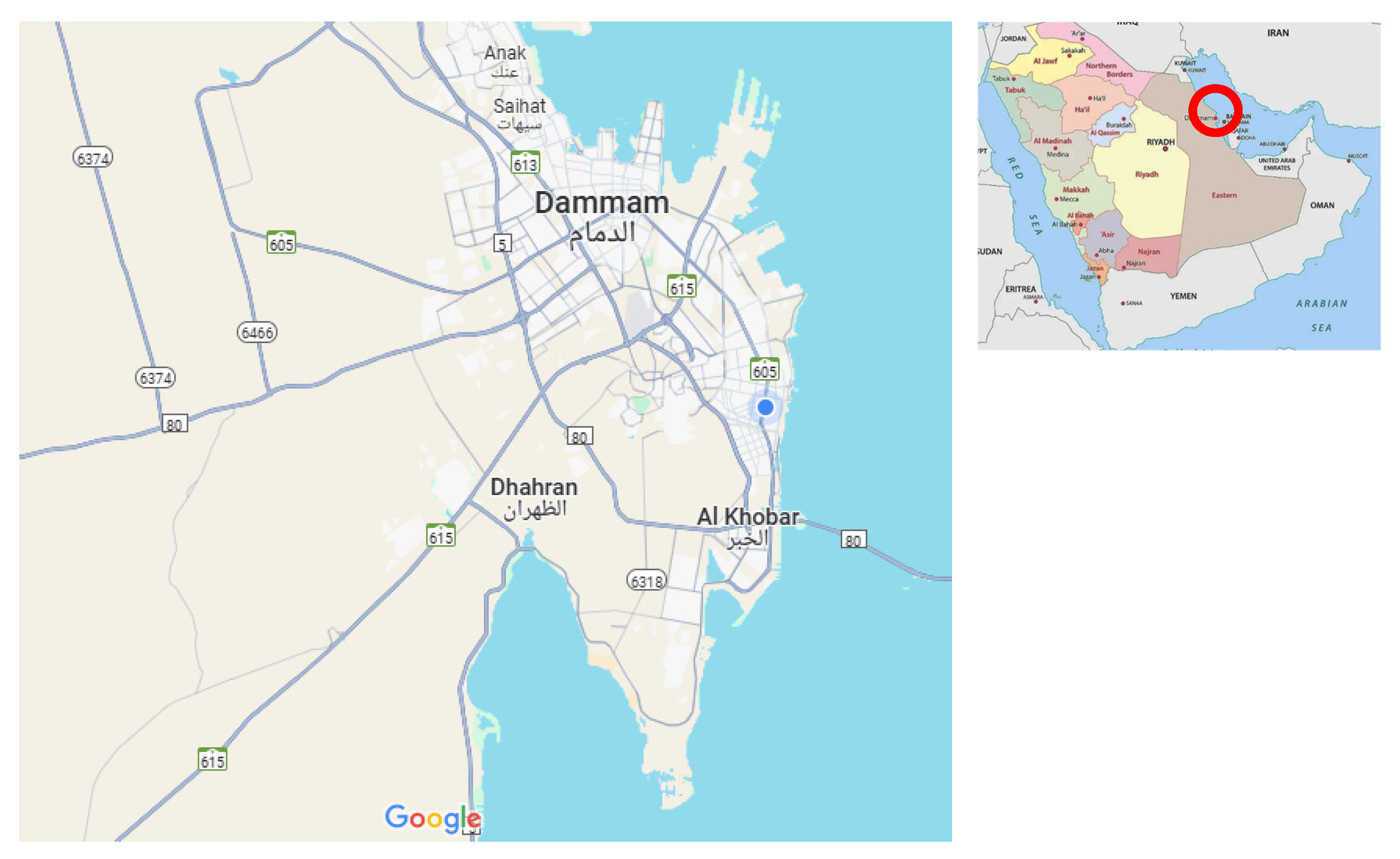
2.2. Data Collection and Analysis
3. Results and Discussion
3.1. Demographic Details of the Experts
3.2. Expert Views on the Road Safety Situation in DMA
3.3. Experts’ Perspectives on the Causes of Car Accidents in DMA
3.4. Experts’ Views on the Current Status of Saher in DMA
3.5. Experts’ Insights on the Role of Saher in Overall Road Safety
3.6. Experts’ Recommendations for Enhancing Road Safety and the Saher System
- The locations for installing Saher cameras should be identified for the drivers;
- It is recommended to maintain a reasonable distance between different speed limits, such as transitioning from 90 to 80, and then to 70, as such changes can confuse drivers;
- The presence of undercover police should be increased to address tailgating and aggressive driving;
- Long-range radars should be installed on the major highways inside and outside cities;
- Automated weigh-in-motion truck scales should be used on the highways instead of fixed scales.
3.7. Overview of the Analysis
4. Conclusions and Recommendations
- Developing Saher Coverage Policies: Use accident and demographic data to ensure equitable camera placement across DMA, minimizing unintended socioeconomic disparities. Cameras should be evenly distributed, avoiding over-concentration in specific neighborhoods. Additionally, work zones, schools, and pedestrian-friendly areas should be prioritized under the Saher coverage policy.
- Expanding Violation Categories: The Saher system should incorporate new infractions, such as hard shoulder driving and blocking right turns, to enhance enforcement and improve road safety.
- Establishing Consistent Evaluation Metrics (KPIs): Define clear success indicators, such as reductions in collisions, injuries, and fatalities. Conducting cost-benefit analyses will help assess long-term program effectiveness.
- Implementing Behavioral Interventions: Strengthen camera enforcement with public safety campaigns and driver education programs tailored to the urban environment. Transparently share accident reduction data to build public trust and emphasize the safety benefits of enforcement over punitive measures.
- Enhancing Legal and Administrative Support: Update traffic laws to support camera-based enforcement, ensuring penalties are enforceable and transparent. Allocate funding for camera maintenance, upgrades, and expansion based on study insights.
- Integrating Traffic Infrastructure Measures: Complement camera enforcement with physical road safety improvements, such as speed humps, road narrowing, and enhanced signage. Pavement markings and advanced warning signs can further enhance overall road safety in DMA.
- Financial Implications and Phased Implementation: The implementation of these measures should follow a phased approach to optimize resource allocation and financial feasibility. The initial phase should focus on policy development, legal adjustments, and pilot programs in high-risk areas. The second phase should expand coverage, add new violations, and integrate behavioral interventions. The final phase should assess program effectiveness, refine enforcement strategies, and secure long-term funding for system upgrades and maintenance. A detailed financial plan should outline projected costs, revenue sources (e.g., fines, government funding, or public-private partnerships), and return on investment to ensure the program’s sustainability.
Author Contributions
Funding
Institutional Review Board Statement
Informed Consent Statement
Data Availability Statement
Conflicts of Interest
References
- Forum, I.T. ITF Research Reports Safer City Streets Global Benchmarking for Urban Road Safety: Global Benchmarking for Urban Road Safety; OECD Publishing: Paris, France, 2018. [Google Scholar]
- WHO. Global Status Report on Alcohol and Health 2018; World Health Organization: Geneva, Switzerland, 2018. [Google Scholar]
- Al-Tit, A.A.; Ben Dhaou, I.; Albejaidi, F.M.; Alshitawi, M.S. Traffic safety factors in the Qassim region of Saudi Arabia. Sage Open 2020, 10, 2. [Google Scholar] [CrossRef]
- WHO. Global Status Report on Road Safety 2018; World Health Organization: Geneva, Switzerland, 2019. [Google Scholar]
- Singh, S. Critical Reasons for Crashes Investigated in the National Motor Vehicle Crash Causation Survey; National Center for Statistics and Analysis: Washington, DC, USA, 2015. [Google Scholar]
- Alqahtany, A.; Bin Mohanna, A. Housing challenges in Saudi Arabia: The shortage of suitable housing units for various socioeconomic segments of Saudi society. Hous. Care Support 2019, 22, 162–178. [Google Scholar] [CrossRef]
- Jamal, A.; Rahman, M.T.; Al-Ahmadi, H.M.; Ullah, I.; Zahid, M. Intelligent intersection control for delay optimization: Using meta-heuristic search algorithms. Sustainability 2020, 12, 1896. [Google Scholar] [CrossRef]
- Al-Turki, M.; Jamal, A.; Al-Ahmadi, H.M.; Al-Sughaiyer, M.A.; Zahid, M. On the potential impacts of smart traffic control for delay, fuel energy consumption, and emissions: An NSGA-II-based optimization case study from Dhahran, Saudi Arabia. Sustainability 2020, 12, 7394. [Google Scholar] [CrossRef]
- Ansari, S.; Akhdar, F.; Mandoorah, M.; Moutaery, K. Causes and effects of road traffic accidents in Saudi Arabia. Public Health 2000, 114, 37–39. [Google Scholar] [CrossRef]
- Mohamed, H.A. Estimation of socio-economic cost of road accidents in Saudi Arabia: Willingness-to-pay approach (WTP). Adv. Manag. Appl. Econ. 2015, 5, 43. [Google Scholar]
- Alqahtany, A.; Jamil, R. Evaluation of Educational Strategies in the Design Process of Infrastructure for a Healthy Sustainable Housing Community. Ain Shams Eng. J. 2022, 13, 101665. [Google Scholar] [CrossRef]
- Al-Ahmadi, H.M. Analysis of Traffic Accidents in Saudi Arabia: Safety Effectiveness Evaluation of SAHER Enforcement System. Arab J. Sci. Eng. 2023, 48, 5493–5506. [Google Scholar] [CrossRef]
- Goldenbeld, C.; van Schagen, I. The effects of speed enforcement with mobile radar on speed and accidents: An evaluation study on rural roads in the Dutch province Friesland. Accid. Anal. Prev. 2005, 37, 1135–1144. [Google Scholar] [CrossRef]
- Soole, D.W.; Watson, B.C.; Fleiter, J.J. Effects of average speed enforcement on speed compliance and crashes: A review of the literature. Accid. Anal. Prev. 2013, 54, 46–56. [Google Scholar] [CrossRef]
- Mountain, L.J.; Hirst, W.M.; Maher, M.J. Are speed enforcement cameras more effective than other speed management measures?: The impact of speed management schemes on 30 mph roads. Accid. Anal. Prev. 2005, 37, 742–754. [Google Scholar] [CrossRef] [PubMed]
- De Pauw, E.; Daniels, S.; Brijs, T.; Hermans, E.; Wets, G. Automated section speed control on motorways: An evaluation of the effect on driving speed. Accid. Anal. Prev. 2014, 73, 313–322. [Google Scholar] [PubMed]
- Lave, C.A. Speeding, coordination, and the 55 mph limit. Am. Econ. Rev. 1985, 75, 1159–1164. [Google Scholar]
- Claros, B.; Sun, C.; Edara, P. Safety effectiveness and crash cost benefit of red light cameras in Missouri. Traffic Inj. Prev. 2017, 18, 70–76. [Google Scholar] [PubMed]
- Zahid, M.; Jamal, A.; Chen, Y.; Ahmed, T.; Ijaz, M. Predicting red light running violation using machine learning classifiers. In Green Connected Automated Transportation and Safety, Proceedings of the 11th International Conference on Green Intelligent Transportation Systems and Safety, Beijing, China, 17–19 October 2020; Springer: Berlin/Heidelberg, Germany, 2022; pp. 137–148. [Google Scholar]
- Al Turki, Y.A. How can Saudi Arabia use the Decade of Action for Road Safety to catalyse road traffic injury prevention policy and interventions? Int. J. Inj. Control Saf. Promot. 2014, 21, 397–402. [Google Scholar] [CrossRef]
- Alobaodallah, A.M.; Alqahtany, A.; Maniruzzaman, K.M. Safety Effectiveness of Automated Traffic Enforcement Systems: A Critical Analysis of Existing Challenges and Solutions. Future Transp. 2025, 5, 25. [Google Scholar] [CrossRef]
- Ghaffar, U.B.; Ahmed, S. A Review of Road traffic accident in Saudi Arabia: The neglected epidemic. Indian J. Forensic Community Med. 2015, 2, 242. [Google Scholar] [CrossRef]
- Alghnam, S.; Alyabsi, M.; Aburas, A.; Alqahtani, T.; Bajowaiber, M.; Alghamdi, A.; Alqunaibet, A. Predictors of Seatbelt Use Among Saudi Adults: Results from the National Biobank Project. Front. Public Health 2020, 8, 579071. [Google Scholar] [CrossRef]
- Bendak, S. An in-depth analysis of red light crossing problem in Saudi Arabia. Adv. Transp. Stud. 2011, 25, 67–74. [Google Scholar]
- Rahman, M.M.; Islam, K.; Al-Shayeb, A. Arifuzzaman Towards Sustainable Road Safety in Saudi Arabia: Exploring Traffic Accident Causes Associated with Driving Behavior Using a Bayesian Belief Network. Sustainability 2022, 14, 6315. [Google Scholar]
- Aldossari, M.; Bandara, N.; Al-Werfalli, D. Implications of Resistance to Automated Speed Enforcement and Red-Light Cam-era Implementation. In Proceedings of the International Conference on Transportation and Development 2023, Austin, TX, USA, 14–17 June 2023; American Society of Civil Engineers: Reston, DC, USA, 2023; pp. 1–9. [Google Scholar]
- Owais, M.; El Sayed, M.A. Red light crossing violations modelling using deep learning and variance-based sensitivity analysis. Expert Syst. Appl. 2024, 267, 126258. [Google Scholar] [CrossRef]
- MOI. “Saher System”, General Department of Traffic, Ministry of Interior. 2025. Available online: https://www.moi.gov.sa/ (accessed on 2 February 2025).
- Life in Saudi Arabia, “8 Features of Saher Camera System in KSA”. Available online: https://lifeinsaudiarabia.net/5-facts-about-new-saher-cameras-of/ (accessed on 6 February 2025).
- Arab News, “Saudi Arabia Clamps Down on Motorists Who Commit Violations”. Available online: https://www.arabnews.com/node/1259931/saudi-arabia (accessed on 6 February 2025).
- Gains, A.; Nordstrom, M.; Heydecker, B.G.; Shrewsbury, J. The National Safety Camera Programme: Four-Year Evaluation Report. 2005. Available online: https://discovery.ucl.ac.uk/id/eprint/1338/1/2004_31.pdf (accessed on 20 February 2025).
- Bates, L.; Watson, B.; King, M. The structure of the learner license affects the type of experiences novices gain during this phase—Examples from Queensland and New South Wales. J. Australas. Coll. Road Saf. 2008, 19, 36–42. [Google Scholar]
- Chen, L.; Chen, C.; Ewing, R. The relative effectiveness of pedestrian safety countermeasures at urban intersections—Lessons from a New York City experience. In Proceedings of the Transportation Research Board (TRB) 91st Annual Meeting, Washington, DC, USA, 22–26 January 2012. [Google Scholar]
- Elvik, R.; Sogge, C.V.; Lager, L.; Amundsen, F.H.; Pasnin, L.T.; Karlsen, R.; Fosli, K. Assessing the efficiency of priorities for traffic law enforcement in Norway. Accid. Anal. Prev. 2012, 47, 146–152. [Google Scholar]
- Shaaban, K.; Mohammad, A.; Eleimat, A. Effectiveness of a fixed speed camera traffic enforcement system in a developing country. Ain Shams Eng. J. 2023, 14, 102154. [Google Scholar] [CrossRef]
- De Albuquerque, F.D.B.; Awadalla, D.M. Characterization of road crashes in the emirate of Abu Dhabi. Transp. Res. Procedia 2020, 48, 1095–1110. [Google Scholar]
- Høye, A. Speed cameras, section control, and kangaroo jumps—A meta-analysis. Accid. Anal. Prev. 2014, 73, 200–208. [Google Scholar]
- Alqahtany, A.M.; Abubakar, I.R. Public perception and attitudes to disaster risks in a coastal metropolis of Saudi Arabia. Int. J. Disaster Risk Reduct. 2020, 44, 101422. [Google Scholar] [CrossRef]
- Alyami, S.H.; Abd El Aal, A.K.; Alqahtany, A.; Aldossary, N.A.; Jamil, R.; Almohassen, A.; Alzenifeer, B.M.; Kamh, H.M.; Fenais, A.S.; Alsalem, A.H. Developing a Holistic Resilience Framework for Critical Infrastructure Networks of Buildings and Communities in Saudi Arabia. Buildings 2023, 13, 179. [Google Scholar] [CrossRef]
- Aldossary, N.A.; Alzahrani, A.A.; Alghamdi, J.K.; Alqahtany, A.; Jamil, R.; Alyami, S.H. A Procedural Framework to Identify Critical Indicators for the Protection of Environment and Ecosystem during Sustainable Urban Development in South-Western Saudi Arabia. Sustainability 2023, 15, 195. [Google Scholar]
- Alqahtany, A. Evaluating the demographic scenario of gated communities in Dammam metropolitan area, kingdom of Saudi Arabia. Hous. Care Support 2022, 25, 13–30. [Google Scholar]
- Aboukorin, A.A.; Al-shihri, F.S. Rapid Urbanization and Sustainability in Saudi Arabia: The Case of Dammam Metropolitan Area. J. Sustain. Dev. 2015, 8, 52. [Google Scholar] [CrossRef]
- Dano, U.L.; Alqahtany, A. Issues Undermining Public Transport Utilization In Dammam City, Saudi Arabia: An Expert-Based Analysis. J. Sustain. Sci. Manag. 2019, 14, 155–169. [Google Scholar]
- Sharqia Development Authority. Sharqia Land of Prosperity; Sharqia Development Authority: Dammam, Saudi Arabia, 2024. [Google Scholar]
- GoogleEarth Pro. Dammam; Maxar Technologies: Denver, CO, USA, 2025. [Google Scholar]
- Thomas, F.B. The Role of Purposive Sampling Technique As a Tool for Informal Choices in a Social Sciences in Research Methods; Just Agriculture: Jalandhar, India, 2022; Volume 2, pp. 1–8. [Google Scholar]
- Bluman, A.G. Elementary Statistics: A Step by Step Approach, 9th ed.; McGraw-Hill: New York, NY, USA, 2014; ISBN 978-0-07-353498-5. [Google Scholar]
- MOH, Ministry of Health Saudi Arabia. Statistics and Indicators. Available online: https://www.moh.gov.sa/en/Ministry/Statistics/Pages/Traffic-accidents.aspx (accessed on 1 March 2025).
- GAS, General Authority of Statistics. Available online: https://www.stats.gov.sa/en/statistics?index=119025 (accessed on 1 March 2025).
- Ji, Y.; Huang, Y.; Zeng, J.; Ren, L.; Chen, Y. A physical‐data-driven combined strategy for load identification of tire type rail transit vehicle. Reliab. Eng. Syst. Saf. 2025, 253, 110493. [Google Scholar]
- Chen, Y.; Liu, X.; Rao, M.; Qin, Y.; Wang, Z.; Ji, Y. Explicit speed-integrated LSTM network for non-stationary gearbox vibration representation and fault detection under varying speed conditions. Reliab. Eng. Syst. Saf. 2025, 254, 110596. [Google Scholar]
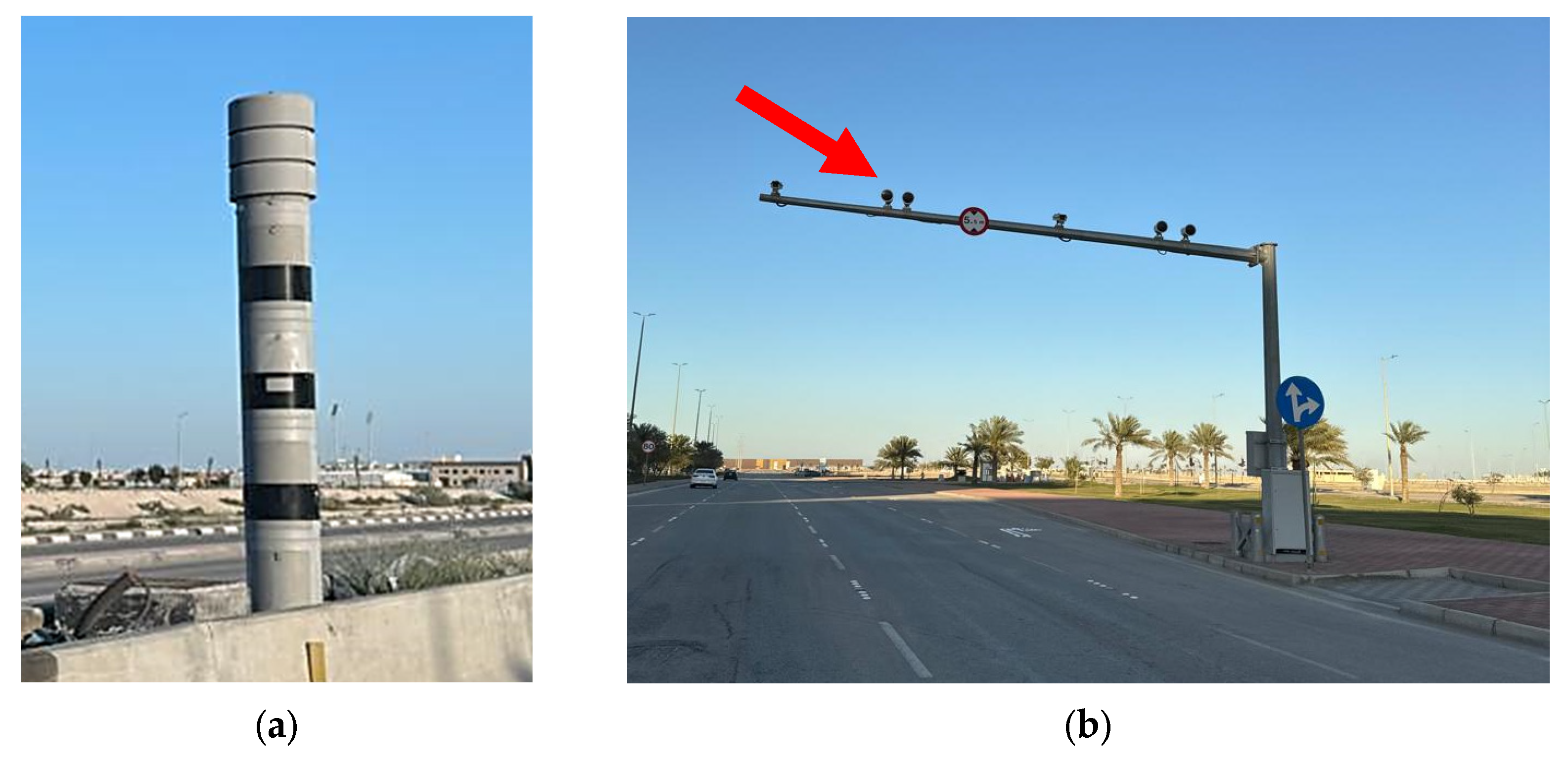



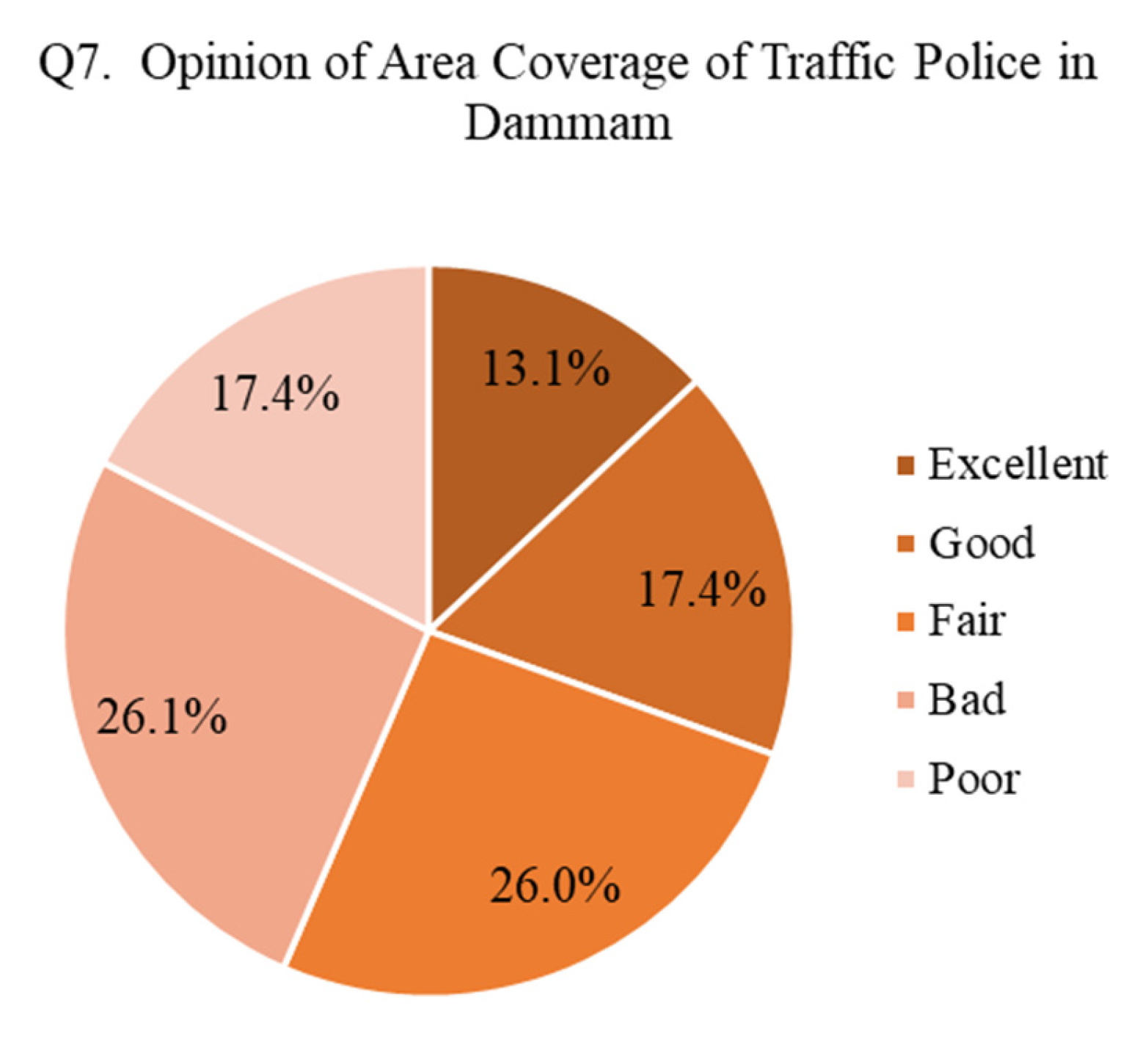
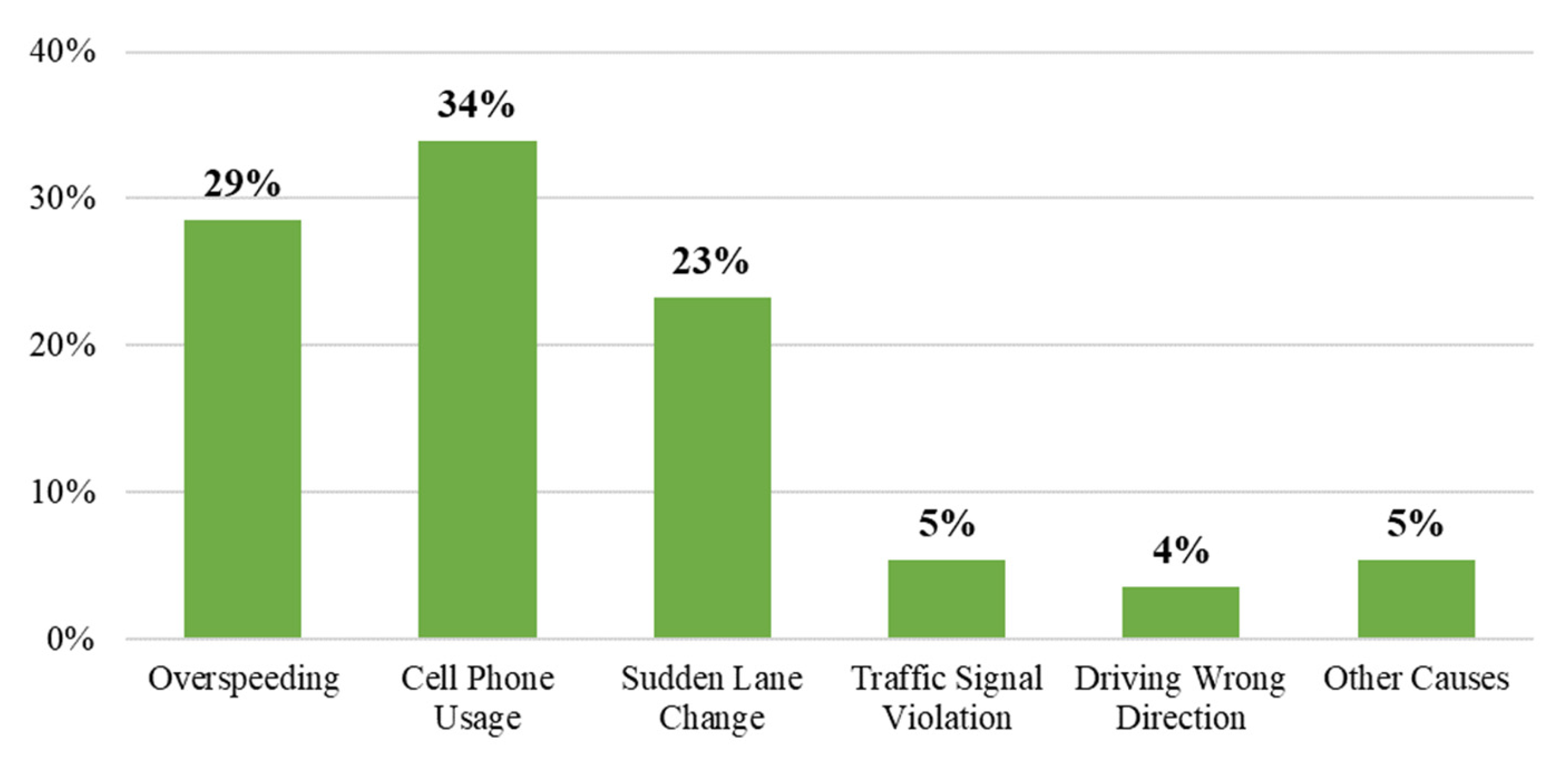

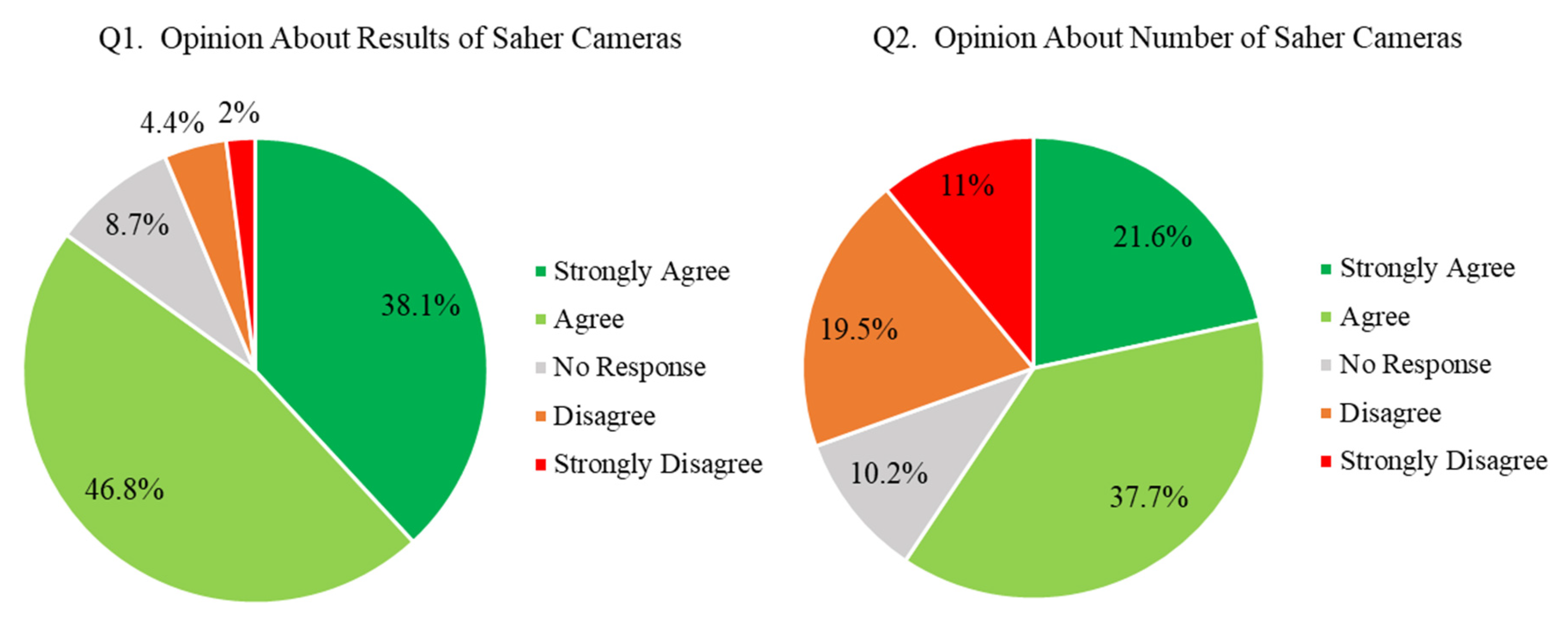



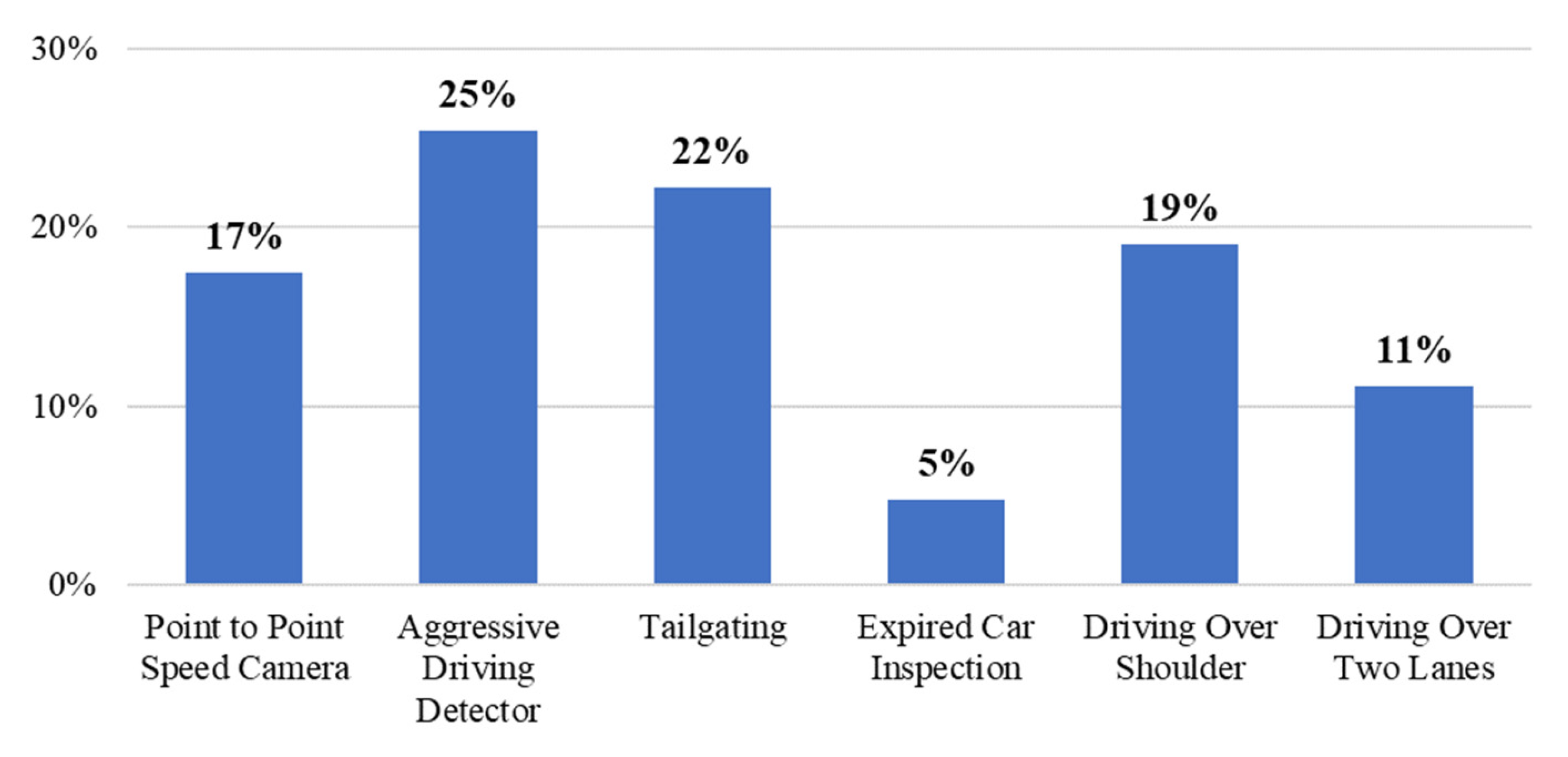
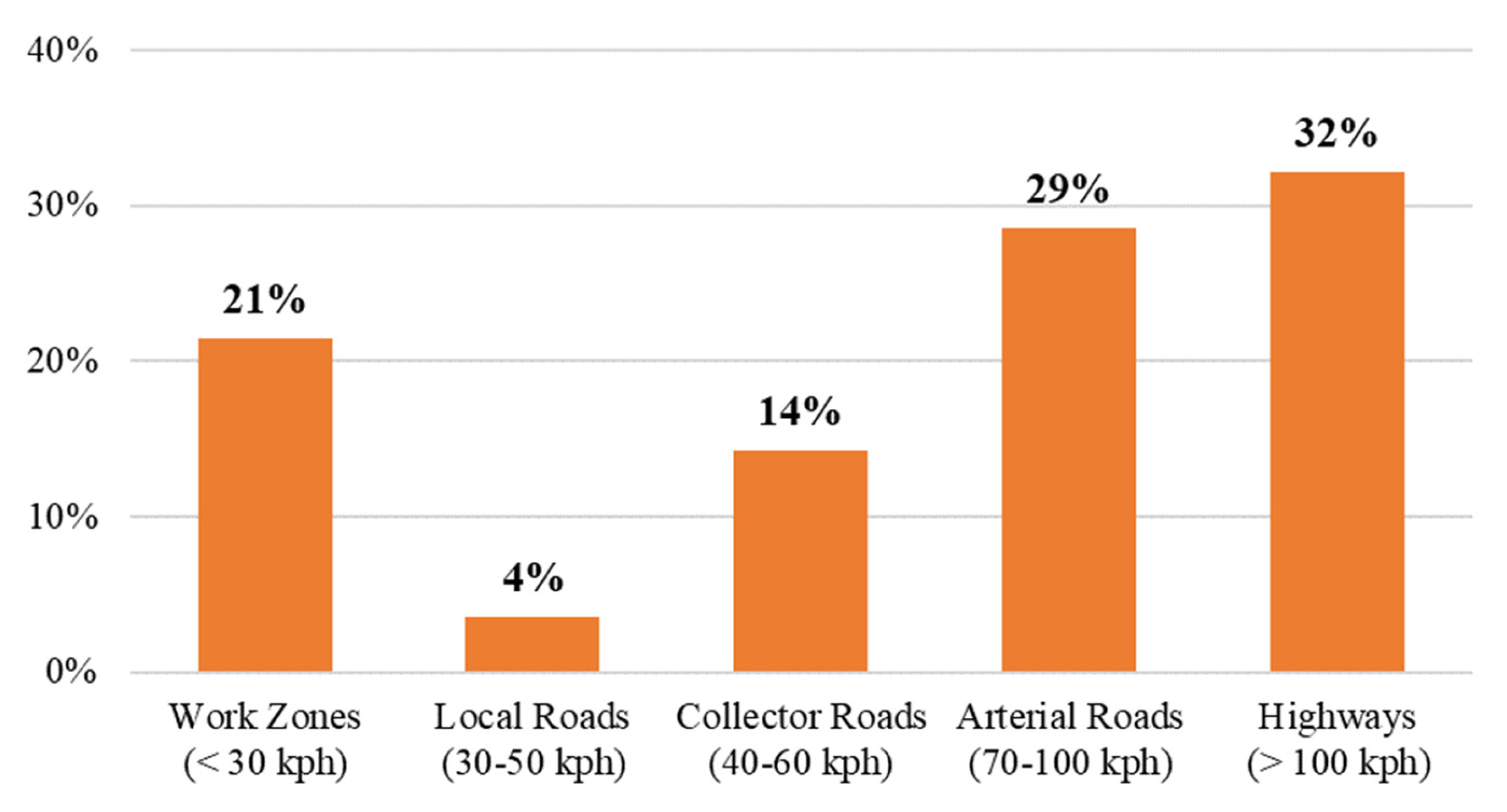
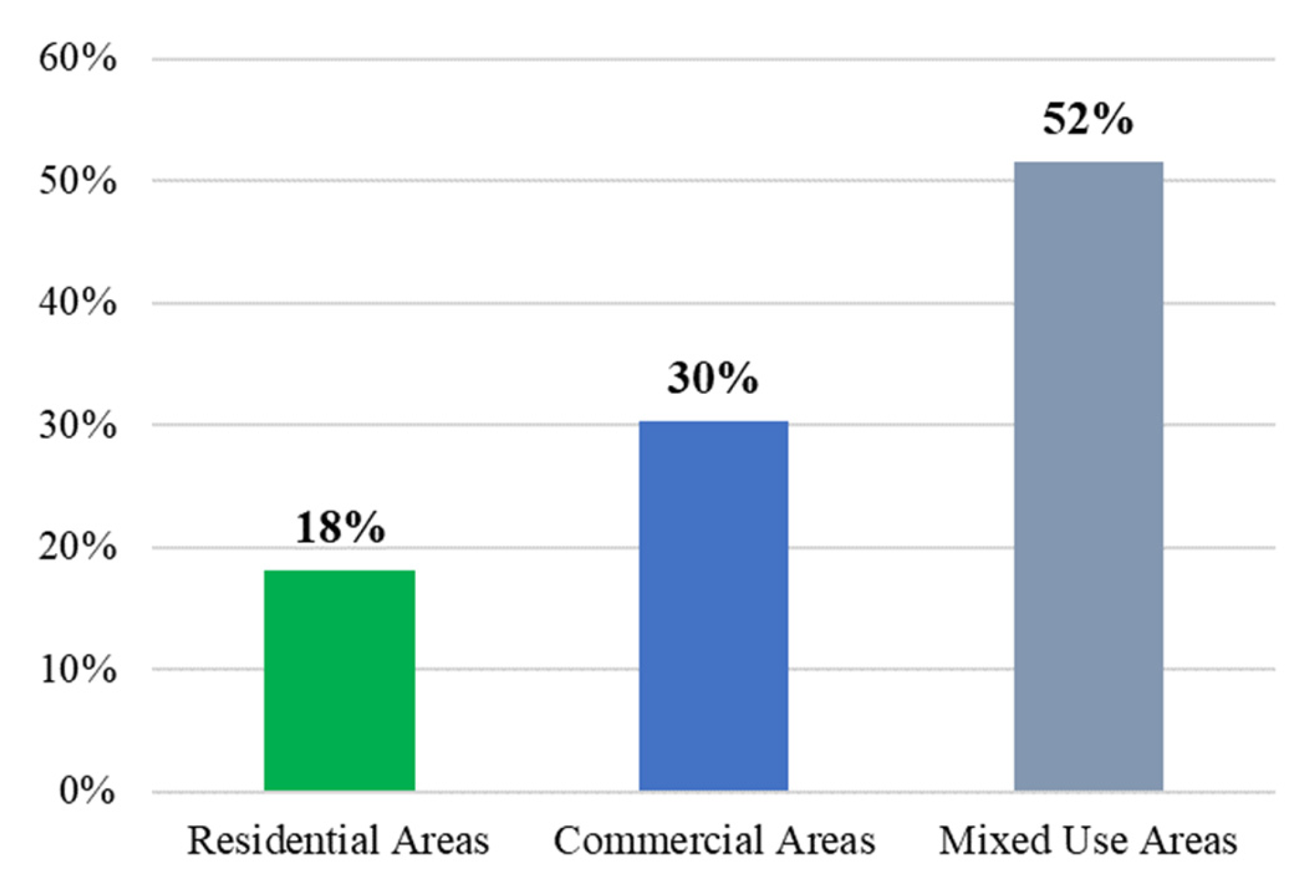
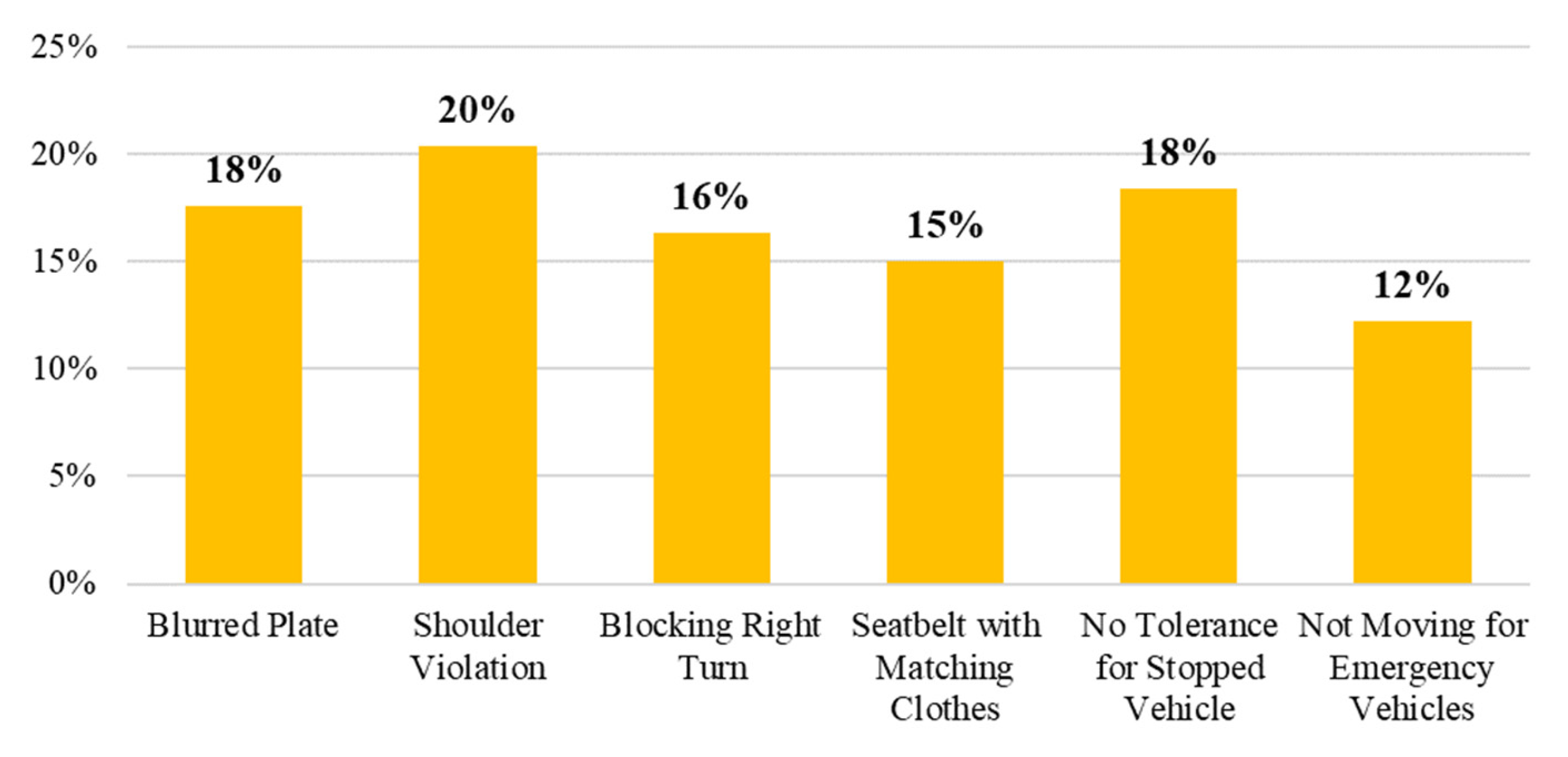


| Characteristics | Categories | No. of Responses | Percentage Response |
|---|---|---|---|
| Age (Years) | 30–40 | 8 | 23.5% |
| 41–50 | 12 | 35.3% | |
| 51–60 | 9 | 26.5% | |
| Above 60 | 5 | 14.7% | |
| Nationality | Saudi | 24 | 70.6% |
| Non-Saudi | 10 | 29.4% | |
| Educational Level | Bachelor’s | 9 | 26.5% |
| Master’s | 12 | 35.3% | |
| Doctorate | 10 | 29.4% | |
| Other | 3 | 8.8% | |
| Employment Type | Private | 7 | 20.6% |
| Government/Public | 16 | 47.1% | |
| Security Forces | 5 | 14.7% | |
| Retired | 6 | 17.6% | |
| Work Experience (years) | 10–15 years | 10 | 29.4% |
| 16–20 years | 9 | 26.5% | |
| 21–25 years | 5 | 14.7% | |
| More than 25 years | 10 | 29.4% | |
| Driving Experience (Years) | Less than 10 years | 3 | 8.8% |
| 10–15 years | 12 | 35.3% | |
| 16–20 years | 8 | 23.5% | |
| 21–25 years | 5 | 14.7% | |
| More than 25 years | 6 | 17.6% |
| Major Causes of Road Accidents | |||||||
|---|---|---|---|---|---|---|---|
| Over Speeding | Cell Phone Usage | Sudden Lane Change | Traffic Signal Violation | Driving Wrong Direction | Other Causes | ||
| Age Group of Violators | Under 17 (Illegal) | 5% | 6% | 3% | 0% | 1% | 1% |
| 17–25 years | 13% | 16% | 12% | 2% | 2% | 3% | |
| 26–35 years | 9% | 9% | 5% | 1% | 1% | 3% | |
| 36–45 years | 1% | 1% | 0% | 0% | 0% | 0% | |
| 46–60 years | 0% | 0% | 1% | 1% | 0% | 0% | |
| Above 60 years | 1% | 1% | 1% | 0% | 0% | 0% | |
| Regression Statistics | |||||
|---|---|---|---|---|---|
| R Square | 0.965 | ||||
| Standard Error | 169.72 | ||||
| Observations | 10 | ||||
| ANOVA (Analysis of Variance) Results | |||||
| df | SS | MS | F-test | F-Significance | |
| Regression | 1 | 6,373,382 | 6,373,382 | 221.26 | 154.24 |
| Residual | 8 | 230,440 | 28,805.01 | ||
| Total | 9 | 6,603,822 | |||
| Coefficients | Standard Error | t Stat | p-value | ||
| Intercept | 565,834.34 | 37,716.92 | 15.0 | 0.0039 | |
| Injuries | −277.94 | 18.69 | −14.87 | 0.0041 | |
Disclaimer/Publisher’s Note: The statements, opinions and data contained in all publications are solely those of the individual author(s) and contributor(s) and not of MDPI and/or the editor(s). MDPI and/or the editor(s) disclaim responsibility for any injury to people or property resulting from any ideas, methods, instructions or products referred to in the content. |
© 2025 by the authors. Licensee MDPI, Basel, Switzerland. This article is an open access article distributed under the terms and conditions of the Creative Commons Attribution (CC BY) license (https://creativecommons.org/licenses/by/4.0/).
Share and Cite
Alobaidallah, A.M.; Alqahtany, A.; Maniruzzaman, K.M. Assessment of the Saher System in Enhancing Traffic Control and Road Safety: Insights from Experts for Dammam, Saudi Arabia. Sustainability 2025, 17, 3304. https://doi.org/10.3390/su17083304
Alobaidallah AM, Alqahtany A, Maniruzzaman KM. Assessment of the Saher System in Enhancing Traffic Control and Road Safety: Insights from Experts for Dammam, Saudi Arabia. Sustainability. 2025; 17(8):3304. https://doi.org/10.3390/su17083304
Chicago/Turabian StyleAlobaidallah, Abdullatif Mohammed, Ali Alqahtany, and Khandoker M. Maniruzzaman. 2025. "Assessment of the Saher System in Enhancing Traffic Control and Road Safety: Insights from Experts for Dammam, Saudi Arabia" Sustainability 17, no. 8: 3304. https://doi.org/10.3390/su17083304
APA StyleAlobaidallah, A. M., Alqahtany, A., & Maniruzzaman, K. M. (2025). Assessment of the Saher System in Enhancing Traffic Control and Road Safety: Insights from Experts for Dammam, Saudi Arabia. Sustainability, 17(8), 3304. https://doi.org/10.3390/su17083304







